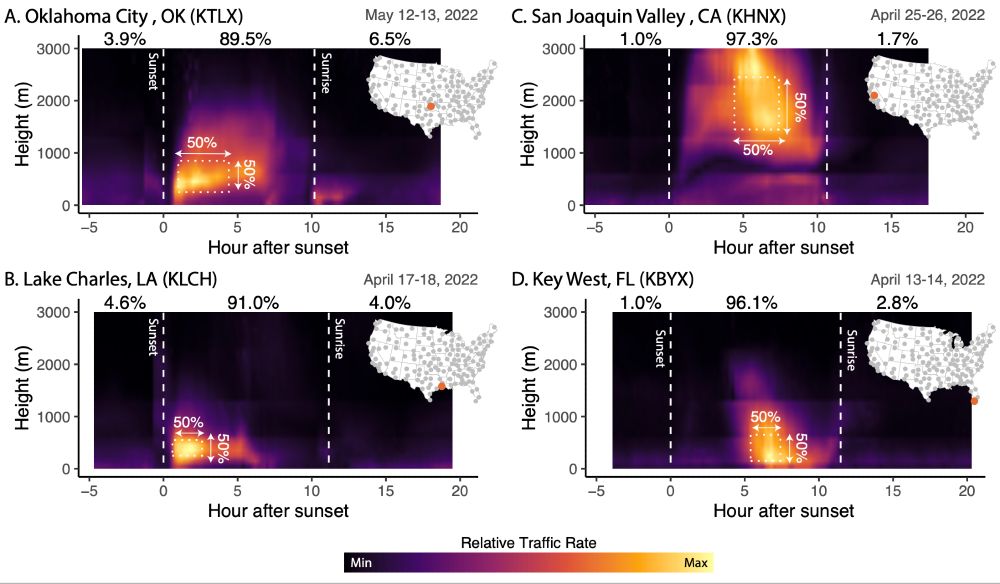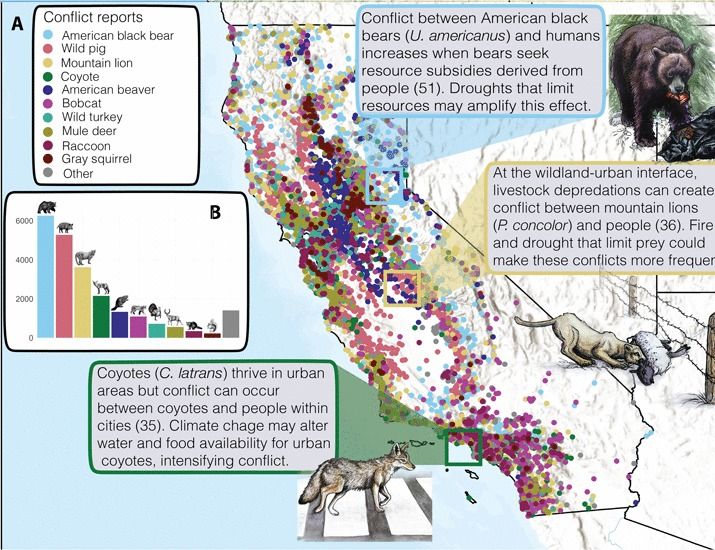
We churned through over 100 million radar samples to quantify the structure of migration through the airspaces across the United States: Just out in Ecology esajournals.onlinelibrary.wiley.com/doi/epdf/10....
20.11.2025 18:20 — 👍 43 🔁 18 💬 2 📌 3@drgodwit.bsky.social
Mass Audubon Bertrand Chair for Ornithology in Dept. Environmental Conservation at UMass Amherst. Fan of all things godwits. Oh, and other birds, and ecology, and evolution, and just cool science generally.

We churned through over 100 million radar samples to quantify the structure of migration through the airspaces across the United States: Just out in Ecology esajournals.onlinelibrary.wiley.com/doi/epdf/10....
20.11.2025 18:20 — 👍 43 🔁 18 💬 2 📌 3The world needs more photos of deer mice on the covers of scientific journals!
20.11.2025 01:21 — 👍 1 🔁 0 💬 1 📌 0Look at that adorable deer mouse with the Rocky Mountains in the background. Nice job @jpvelotta.bsky.social and team on nabbing the image! #fieldwins
20.11.2025 00:49 — 👍 21 🔁 4 💬 1 📌 0
Conflict between humans and wildlife—and especially, carnivores—may increase during times of drought, a new #ScienceAdvances analysis of droughts in California suggests. https://scim.ag/47PutKx
18.11.2025 18:56 — 👍 39 🔁 10 💬 0 📌 1
The first doses of the blockbuster HIV prevention drug lenacapavir have arrived in Africa.
The doses came remarkably fast, just 5 months after approval in the US. But they're entering a system upended by Trump administration aid cuts.
www.npr.org/sections/goa...

"Okay, But… Birds" 🐦🦆🐣 🦉🦜🦩
Listen/watch this science-meets-storytelling podcast about the weird, brilliant, & surprisingly dramatic lives of birds. Hosted by evolutionary biologist Scott Taylor. Premiers Dec 4th www.youtube.com/watch?v=ZiUV...

@conservation.cam.ac.uk @camzoology.bsky.social
Happy to share new research, just out in Ecology @esajournals.bsky.social, led by Meghan Beatty.
We interrogate source-sink dynamics over a 28-year period for the endangered snail kite, testing how an invasion of novel prey alters dynamics...
esajournals.onlinelibrary.wiley.com/doi/10.1002/...

For your consideration, our paper about how we can build a better error culture around biologging is now out in Animal Behavio(u)r. A collaborative effort between researchers the veterinarians at @mpi-animalbehav.bsky.social
www.sciencedirect.com/science/arti...

A hand holding an eastern nashville warbler (Leiothlypis ruficapilla ruficapilla) during bird banding

Going to be a big month for warbler science! First out of the gates is @lannhiphung.bsky.social, with song & genomics of Nashville warblers. Eastern and western subspecies: non-overlapping and super distinct. Keep an eye on your life list 😉
🦉🧪@journal-evo.bsky.social
academic.oup.com/evolut/advan...
Trends in nonbreeding shorebirds along the Pacific Americas Flyway | doi.org/10.1093/orni... | Ornithological Applications | #ornithology 🪶
14.11.2025 13:23 — 👍 6 🔁 2 💬 0 📌 0A couple takeaways from this story:
1. In the tropics, the proportion of non-migrant colliders is higher
2. Structures close to forests tend to kill inter-forest dispersers in the tropics
3. There are a lot of "Dr Tan"s studying birds in Singapore.

“The prohibited activities would include joint research, co-authorship on papers, and advising a foreign graduate student or postdoctoral fellow. The language is retroactive, meaning any interactions during the previous 5 years could make a scientist ineligible for future federal funding.”
14.11.2025 01:03 — 👍 593 🔁 317 💬 60 📌 280
‘Endowed Chair of Ornithology’ jobs don’t come along too often, but here’s one: umiami.wd1.myworkdayjobs.com/en-US/UMFacu...
12.11.2025 21:05 — 👍 2 🔁 1 💬 0 📌 0
How are Pacific NW mountain birds responding to climate change?
I got up at 4:00 am for a month to find out.
but first the backstory, or "how I spent seven years telling everyone this project wasn't possible"
new paper here:
esajournals.onlinelibrary.wiley.com/doi/full/10....

🐺 Advantageous snow conditions – in terms of snow depth and density – are among the most important features of the winter landscape for two apex predators, regardless of hunting strategy.
Read the full paper here ➡️ buff.ly/pXSMNRK

Amy Angert and I are recruiting a #postdoc to participate in a collaborative NSF-funded study of demographic responses to climate across the geographic range of the scarlet monkeyflower. Please repost! jobs.ncsu.edu/postings/224...
07.11.2025 15:10 — 👍 74 🔁 85 💬 1 📌 3

🦢 What a swan’s 570km U-turn could tell us about water, wetlands, and a changing climate.... www.linkedin.com/posts/kane-b...
05.11.2025 21:03 — 👍 32 🔁 8 💬 6 📌 4
I am recruting a #postdoc for a project investigating the evolution of avian heat tolerance in @erc.europa.eu project #HotLife. Fieldwork over broad latitudinal gradients, common-garden experiments, and more. Read more and apply👇
shorturl.at/WA1Qa
Would appreciate a re-post!
@evoldir.bsky.social

Warning. ⚠️ If you are writing an NSF GRFP, new this year, you need official transcripts to apply. Beware. They will not review applications without official transcripts. ‼️
04.11.2025 20:50 — 👍 84 🔁 115 💬 11 📌 7
a couple of individually marked godwits. Photo by J. Seenstra
Want your modelling to save birds? PhD with me at UvA (Amsterdam): build spatial integrated population model for black-tailed godwits with world-class dataset and strong team here & @birdeyes-gfn.bsky.social/RUG). werkenbij.uva.nl/en/vacancies... Apply by 1 Dec 2025: #Ecology #Bayesian #Conservation
04.11.2025 11:31 — 👍 32 🔁 27 💬 1 📌 0
"Regrettably, and despite the null hypothesis being simple, elegant and often underpinned by evidenced or reasoned convictions, conventional p-value analysis can only argue against the null hypothesis, never in favour of it."
02.11.2025 07:55 — 👍 34 🔁 11 💬 3 📌 1
Very happy to finally have this out! 🎉 A review of the diets of European insectivorous birds. Huge thanks to Klaus Birkhofer, @johanekroos.bsky.social, @henrikgsmith.bsky.social and all co-authors! 🙏 #ornithology @biologylu.bsky.social @vogelwarte.bsky.social @helsinki.fi doi.org/10.1016/j.bi...
29.10.2025 08:28 — 👍 29 🔁 14 💬 0 📌 0
Incredible paper - Genomic architecture of eggmimicry and its consequencesfor speciation in parasitic cuckoos www.science.org/doi/epdf/10.... and a great commentary here www.science.org/doi/epdf/10.... @btobirds.bsky.social
31.10.2025 09:30 — 👍 10 🔁 3 💬 0 📌 0
White-necked jacobin, a hummingbird, perched on a branch
Here's my latest contribution to the "Lost Science" series at the New York Times: Jay Falk, a scientist who studies why some female hummingbirds look just like males. Gift link: nyti.ms/4qF7Qje
30.10.2025 14:05 — 👍 203 🔁 43 💬 5 📌 1
Fig. 2. Maps of nocturnal bird migration across the Netherlands in spring and autumn, with the 100 km radius circles of the weather radars enclosing the onshore study area. Colors represent seasonal migration passage, converted from the original bird densities. Shaded areas mark grid cells for which over 25% of the input data, prior to filtering, were impacted by ground clutter. Migration passage in these regions may be compromised in either direction: overestimated due to remaining clutter artifacts or underestimated where terrain features partially obstruct the radar’s lower scanning angles.

Fig. 1. Flight altitude distributions (in m above sea level (asl)) of nocturnal bird migration for both Dutch weather radars at a coastal Den Helder and inland site Herwijnen. Bar length denotes the proportion of migration within the respective altitude range (50 m vertical resolution). Donut charts aggregate this further to coarser 200-m classes and display the proportion of migration occurring above 1000 m (patterned). Red highlights indicate the altitude range of onshore energy infrastructure in the Netherlands, which is generally present in the lowest 200 m of the atmosphere. Donut chart proportions do not sum to 100% due to rounding. The small inset map of the Netherlands shows the locations of both radars (solid dots) and the surrounding areas up to 35 km (circles) from which altitude distributions are aggregated.

Fig. 3. a, c Observed combinations of migration passage and mean wind power density, a measure of wind power potential, in North-Holland. Red circles represent average values for candidate sites and their size reflects the relative candidate site area. The grid reflects binned values of migration and wind power density, with color shading indicating the type of combination: orange = high migration passage, blue = high wind power density, dark browns and blues = both high. White lines indicate averages for wind power density and seasonal migration passage. b Spatial distribution of autumn migration (orange hues) and wind energy (blue hues) in North-Holland. Candidate wind energy sites are shown in bright red. The highest and lowest autumn migration passage sites are linked to their positions in a and c, emphasizing large differences between sites in autumn, but not in spring. Shaded areas mark grid cells for which over 25% of the input data, prior to filtering, were impacted by ground clutter. Migration passage in these regions may be compromised in either direction: overestimated due to remaining clutter artifacts or underestimated where terrain features partially obstruct the radar’s lower scanning angles.
To reduce negative impacts of #renewables (eg #windenergy) on migrating birds, we need to know *where* and how *high* they fly. Using weather radar, we mapped 6yrs of nocturnal migration over the Netherlands, revealing patterns we can use to avoid and minimize impacts:
doi.org/10.1016/j.je... 🧪🪶

Our new @nature.com shows that energy flows mediated by mammals and birds across sub-Saharan Africa have declined by >30% unevenly across functional groups, with major consequences ecosystem functions
shorturl.at/AD0Yb
Listen to our recent work, published in Heredity!
29.10.2025 22:00 — 👍 7 🔁 1 💬 0 📌 0Just a few days left to apply to our TT position in Plant Physiology in the Dept. of Biology @UMassAmherst! Join a great group of plant scientists (and physiologists 😉) AND fall in love with small town New England! Please repost. careers.umass.edu/amherst/en-u...
29.10.2025 15:19 — 👍 4 🔁 4 💬 0 📌 1
NEW PAPER in #ornithology shows that some #raptors switched foraging strategy when #COVID19 lockdowns reduced the availability of #roadkill: buff.ly/jUug7Yj
29.10.2025 08:37 — 👍 23 🔁 11 💬 0 📌 1

Deconstructing the morphological basis of ecogeographic variation in the hand-wing index, a widely used proxy for avian mobility, in the Yellow Warbler (Setophaga petechia)
@asn-amnat.bsky.social doi.org/10.1086/739176
#birds #collectionsareessential #museums #ornithology #evosky